Overview
The article serves as an authoritative guide on effectively stretching your obliques, highlighting the critical role these exercises play in enhancing flexibility, preventing injuries, and boosting athletic performance.
It captivates readers by detailing various stretching techniques and their physiological benefits, while also illustrating the positive impact on overall health and workplace productivity.
This compelling narrative makes a strong case for integrating oblique stretches into regular fitness routines, ultimately advocating for a more health-conscious approach in daily practices.
Introduction
The oblique muscles, often overlooked in fitness discussions, are essential for both athletic performance and everyday movements. Nestled on the sides of the abdomen, these muscles play a critical role in tasks that require trunk rotation and lateral flexion, making them particularly important for athletes in sports such as baseball and golf. As research increasingly underscores the connection between core strength and overall physical performance, understanding the anatomy and function of the obliques becomes imperative.
This article delves into the significance of these muscles, the benefits of stretching them, and practical techniques to incorporate into fitness routines. It emphasizes their importance not just for aesthetics, but also for injury prevention and enhanced athletic capability. With insights from recent studies and real-world examples, the discussion aims to elevate awareness of the obliques' role in a holistic approach to health and fitness.
Understanding the Oblique Muscles: Anatomy and Function
The slanted muscles, located on the sides of the abdomen, are essential for a wide range of physical activities. They are classified into two main categories: the external muscles and the internal muscles. The external muscles, the largest and most superficial of the two, extend diagonally from the lower ribs to the pelvis. Their primary functions include facilitating trunk rotation and lateral flexion, which are essential for understanding how to stretch your obliques during movements such as twisting in sports or bending sideways. Beneath the external muscles lie the internal muscles, which work synergistically with their external counterparts to stabilize the core and enhance movement efficiency. This collaboration is vital for maintaining proper posture, supporting the spine, and enabling effective rotational movements.
The importance of these muscles extends beyond aesthetics; they are integral to athletic performance and injury prevention. In 2025, the significance of robust side muscles in physical activities is underscored by numerous studies linking core strength to improved athletic performance. For instance, athletes with well-developed side muscles demonstrate enhanced rotational power, which is critical in sports like baseball and golf. Furthermore, research indicates that individuals who know how to stretch your obliques through targeted angled exercises experience a notable increase in overall physical performance, including better balance and agility.
Real-world examples illustrate the impact of core strength on athletic activities. For example, professional athletes often include targeted training into their routines to enhance their performance metrics. A case study involving a collegiate soccer team revealed that players who concentrated on enhancing their side muscles showed a marked improvement in their sprinting speed and agility on the field. Additionally, knowledge of the vascular anatomy, such as the pedicle length of the DIEAP flap, which ranges from 1.5 to 4 cm, can provide relevant anatomical context that enhances the understanding of muscle structure and function.
Statistics further highlight the importance of these muscles; studies have shown that athletes with strong lateral muscles are 30% more likely to excel in rotational sports compared to those with weaker core muscles. This correlation highlights the need for specialized training programs that include exercises on how to stretch your obliques for lateral strengthening. Moreover, damage to the inferior muscle during surgery can lead to significant consequences, such as diplopia and strabismus, underscoring the importance of these muscles in both athletic performance and medical contexts.
In summary, the muscles are not only essential for basic movements but also play a pivotal role in enhancing athletic performance and preventing injuries. Their development should be a priority for anyone looking to improve their physical capabilities and overall fitness. By incorporating angled strengthening into corporate wellness initiatives, organizations can foster a healthier team culture, aligning with Foresight Health Coaching's mission to enhance workplace well-being.

The Importance of Stretching Your Obliques for Health and Performance
Learning how to stretch your obliques is essential for a variety of reasons that extend beyond mere adaptability. Improved adaptability contributes significantly to overall mobility and performance in various physical activities. Research indicates that enhanced suppleness can lead to better posture, which in turn significantly reduces the risk of injuries, particularly in athletic contexts.
For instance, a study involving 3,000 middle-aged adults revealed that higher flexibility scores correlate with a 15% lower risk of all-cause mortality, underscoring the long-term health benefits of maintaining flexibility.
Moreover, knowing how to stretch your obliques can alleviate tension in the lower back, a common issue linked to tight side muscles. This tension relief not only contributes to comfort but also enhances overall physical performance. By learning how to stretch your obliques and incorporating those stretches into your routine, you promote better blood circulation, crucial for muscle recovery and overall physical health.
The advantages of adaptability extend into the workplace as well. Employees who participate in regular flexibility routines report improved posture and reduced discomfort, leading to enhanced productivity. In fact, adaptability training has been shown to enhance workplace performance metrics, with employees experiencing increased motivation and engagement.
This is especially pertinent in today's corporate landscape, where organizations increasingly acknowledge the significance of wellness programs that incorporate flexibility and mobility workshops, such as those provided by Foresight Health Coaching.
Foresight Health Coaching offers tailored corporate memberships that include in-person wellness talks, comprehensive pantry and nutrition services, and access to our exclusive health and wellness app. These services are designed to foster a healthy workplace environment and cater to the unique needs of each organization, ensuring flexibility and scalability for all business sizes.
Real-world examples emphasize the effectiveness of flexibility exercises for athletic performance. Fitness professionals are encouraged to integrate dedicated flexibility classes into their offerings, particularly for older populations aiming to enhance their quality of life. Such initiatives not only improve member engagement but also position businesses as leaders in wellness solutions.
The case study of Serotonin Centers highlights the significance of including flexibility exercises in wellness programs, demonstrating how these practices can improve the quality of life for participants.
As Howard E. LeWine, MD, notes, "It takes weeks to months to get flexible, and you'll have to continue working on it to maintain it." This quote emphasizes the dedication needed for adaptive training, essential for achieving long-term benefits.
In summary, understanding how to stretch your obliques is of great significance. It is a key element in nurturing adaptability, enhancing athletic performance, and promoting overall health, making it an essential practice for anyone looking to improve their physical capabilities. Furthermore, by partnering with Foresight Health Coaching, organizations can build a stronger and more resilient team culture, aligning with the growing recognition of wellness initiatives in the workplace.
Contact us today to learn more about how our tailored wellness programs can benefit your team.
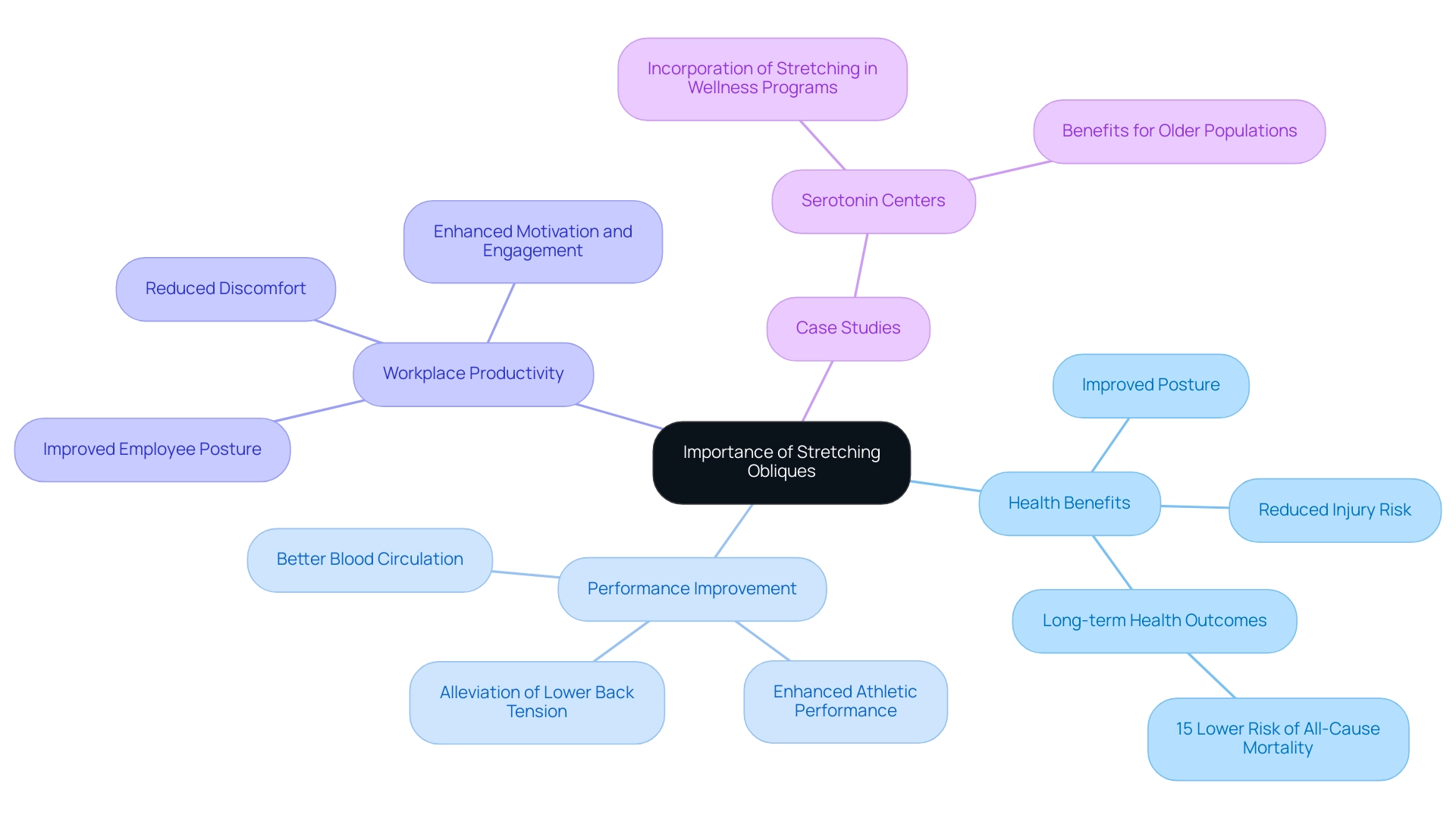
Top Oblique Stretches to Enhance Flexibility and Mobility
To enhance flexibility and mobility, understanding how to stretch your obliques is crucial. Incorporating effective exercises into your routine can significantly benefit your overall well-being. Here are some top exercises that can be effortlessly integrated into corporate wellness programs:
-
Standing Side Bend Stretch: Stand tall with your feet shoulder-width apart. Lift your left arm above your head and lean to the right, feeling the pull along your left side. Hold for 15-30 seconds before switching sides. This exercise not only improves flexibility but also promotes better posture, essential for long hours at a desk.
-
Seated Russian Twist Stretch: Sit on the floor with your knees bent. Lean back slightly and twist your torso to the right, placing your left hand on your right knee. Hold for a few seconds and switch sides. This dynamic exercise demonstrates how to stretch your obliques, activating the side abdominal muscles and improving core stability, vital for overall athletic performance.
-
Lying Torso Twist: Lie on your back with your arms extended out to the sides. Bend your knees and gently drop them to one side while keeping your shoulders on the ground. Hold for 15-30 seconds and switch sides. This exercise is particularly effective for relieving tension in the lower back, a common issue for those who sit for extended periods.
-
Side Plank Reach-Through Stretch: Start in a side plank position. Reach your top arm under your body and twist your torso, then return to the starting position. Repeat on both sides. This exercise is an excellent method to learn how to stretch your obliques while also focusing on the side muscles, improving overall core strength and stability, making it a beneficial addition to any fitness regimen.
Incorporating these movements into daily routines can lead to enhanced flexibility and mobility, which are crucial for sustaining high performance in the workplace. Studies indicate that regular stretching can significantly reduce the risk of injury and enhance overall employee well-being, contributing to a more productive work environment. By prioritizing these practices, organizations can foster a culture of health that supports both individual and collective success.
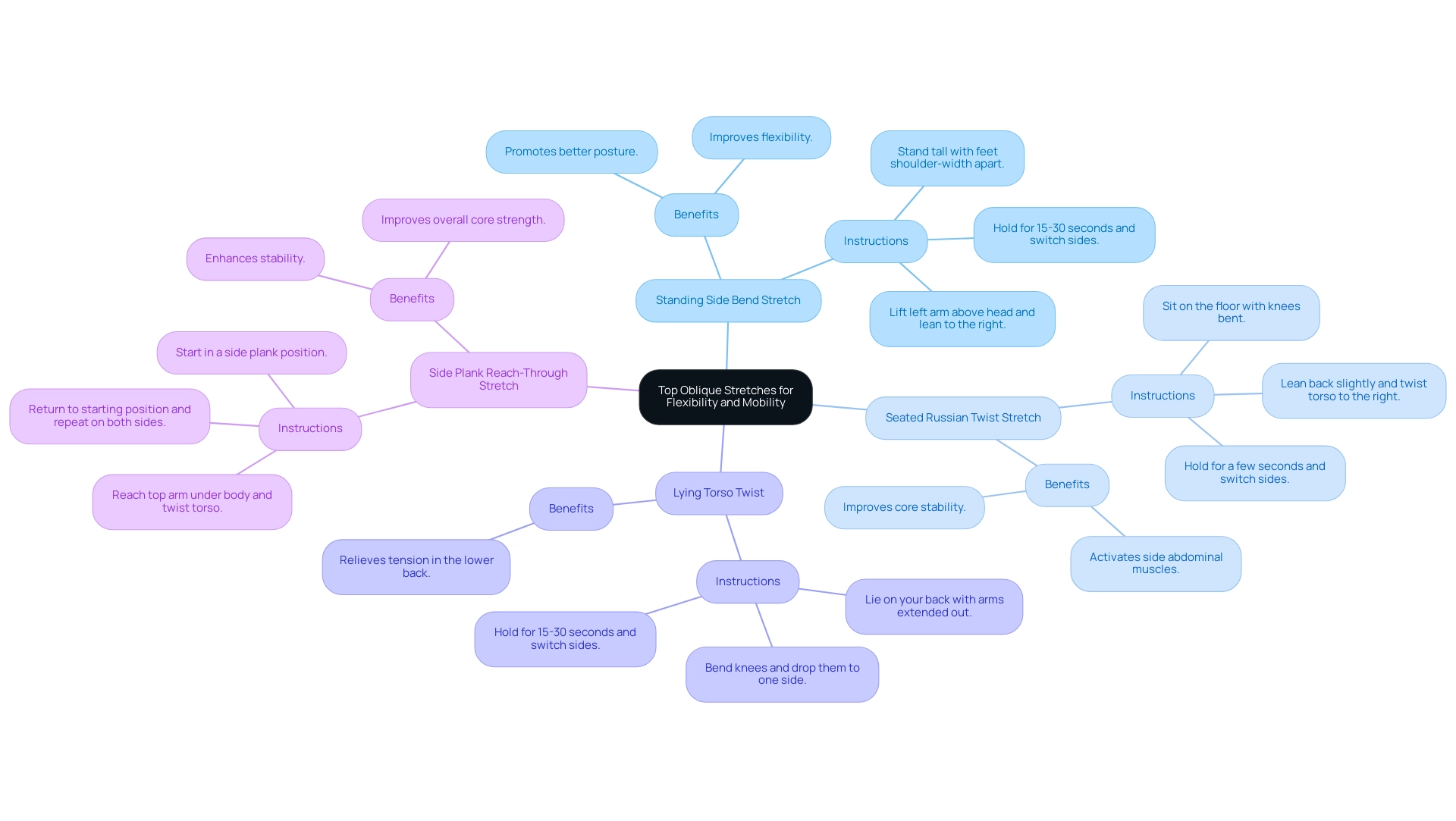
Step-by-Step Guide to Performing Key Oblique Stretches
To perform key oblique stretches safely and effectively, follow these steps:
-
Standing Side Bend Stretch:
- Stand with your feet shoulder-width apart.
- Raise your left arm overhead and lean to the right, ensuring your hips remain stable.
- Experience the elongation along your left side, holding for 15-30 seconds before changing sides.
-
Seated Russian Twist Stretch:
- Sit on the floor with your knees bent and feet flat on the ground.
- Lean back slightly while maintaining a straight back.
- Twist your torso to the right, placing your left hand on your right knee, and hold for a few seconds before switching sides.
-
Lying Torso Twist:
- Lie on your back with your arms extended out to the sides.
- Bend your knees and gently drop them to the right side, keeping your shoulders grounded.
- Hold this position for 15-30 seconds, then switch sides and repeat.
-
Side Plank Reach-Through Stretch:
- Begin in a side plank position with your elbow directly under your shoulder.
- Reach your top arm under your body, twisting your torso to improve the extension.
- Return to the starting position and repeat on both sides.
Learning how to stretch your obliques can significantly improve flexibility and lower the risk of injury when included in your routine. Research indicates that dynamic flexibility exercises were more effective at achieving an increase in hamstring extensibility and stretch tolerance one hour post-intervention than static methods. However, for recovery from injuries such as hamstring strains, static elongation has proven to be more beneficial.
As noted by Howard E. LeWine, MD, it takes weeks to months to get flexible, and ongoing effort is necessary to maintain it. Furthermore, a case study titled 'Extending in Rehabilitation and Pain Management' emphasizes that static elongation is effective for recovery from hamstring strains and plays a crucial role in rehabilitation environments. It is also important to note that stretching may not benefit neurological patients who have had strokes or spinal cord injuries, emphasizing the need for a balanced view of stretching practices.
These insights make these exercises a valuable addition to any fitness regimen.
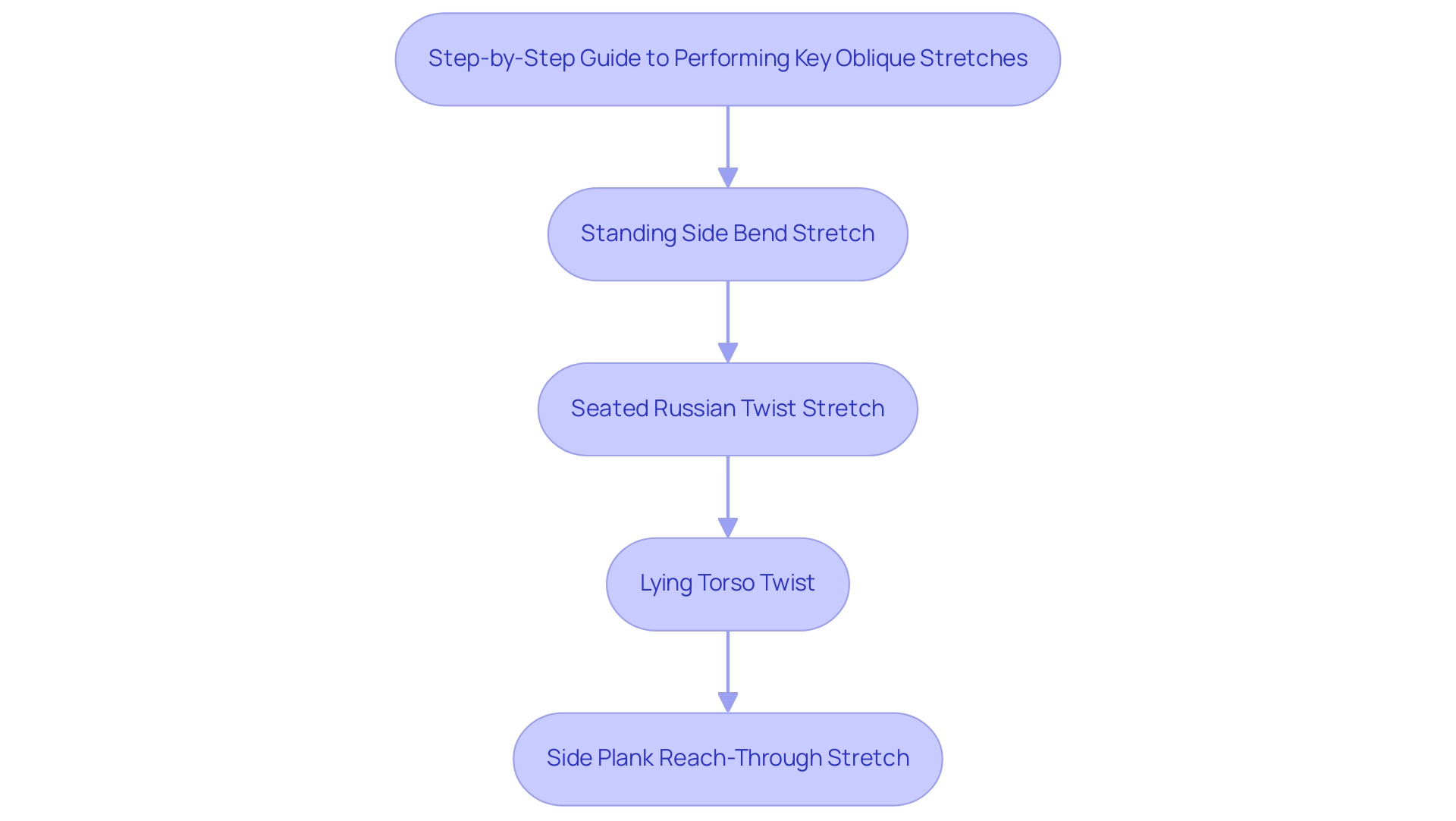
Preventing Injuries: How Oblique Stretches Support Recovery and Performance
Incorporating angled stretches into your routine is crucial for minimizing injury risks, especially for those involved in sports or physical activities. To mitigate injuries stemming from tight oblique muscles that may lead to imbalances and strain on the lower back, mastering oblique stretches is imperative. Regular elongation not only preserves flexibility but also enhances range of motion and alleviates muscle tension.
Furthermore, flexibility exercises are vital for recovery, as they promote blood flow to the muscles, reducing soreness and stiffness. Research indicates that dynamic flexibility exercises can diminish post-exercise tightness and soreness, facilitating recovery after training.
A study revealed that participants who engaged in dynamic exercises three times a week for six weeks exhibited significant improvements in 4.5- and 9-meter sprint tests, underscoring the effectiveness of this practice in enhancing physical capabilities. Moreover, expert insights emphasize the importance of flexibility in injury recovery. Dr. Jagim, Director of Sports Medicine Research at Mayo Clinic Health System, remarked, "However, if you are crunched for time, it’s better to get in your full workout and move on with your day than to cut your workout short so you have time to stretch."
This perspective underscores the necessity of balancing flexibility exercises with overall workout routines.
Additionally, the limitations present in dynamic stretching research highlight the need for more rigorous studies to clarify the benefits of dynamic stretching, as existing literature lacks comprehensive details concerning stretching intensity and duration. By prioritizing angled extensions, you not only enhance your range of motion but also support your body’s recovery mechanisms, ultimately leading to improved performance in your physical activities.
The importance of flexibility in injury prevention cannot be overstated. A flexible body is better equipped to handle the demands of physical activity, thereby reducing the likelihood of strains and sprains. Therefore, incorporating angled stretches into your fitness routine is a proactive strategy to protect your health and enhance your performance.
Foresight Health Coaching's partnership offers organizations an opportunity to cultivate a healthier and more cohesive team culture, emphasizing the significance of wellness through activities such as exercise.
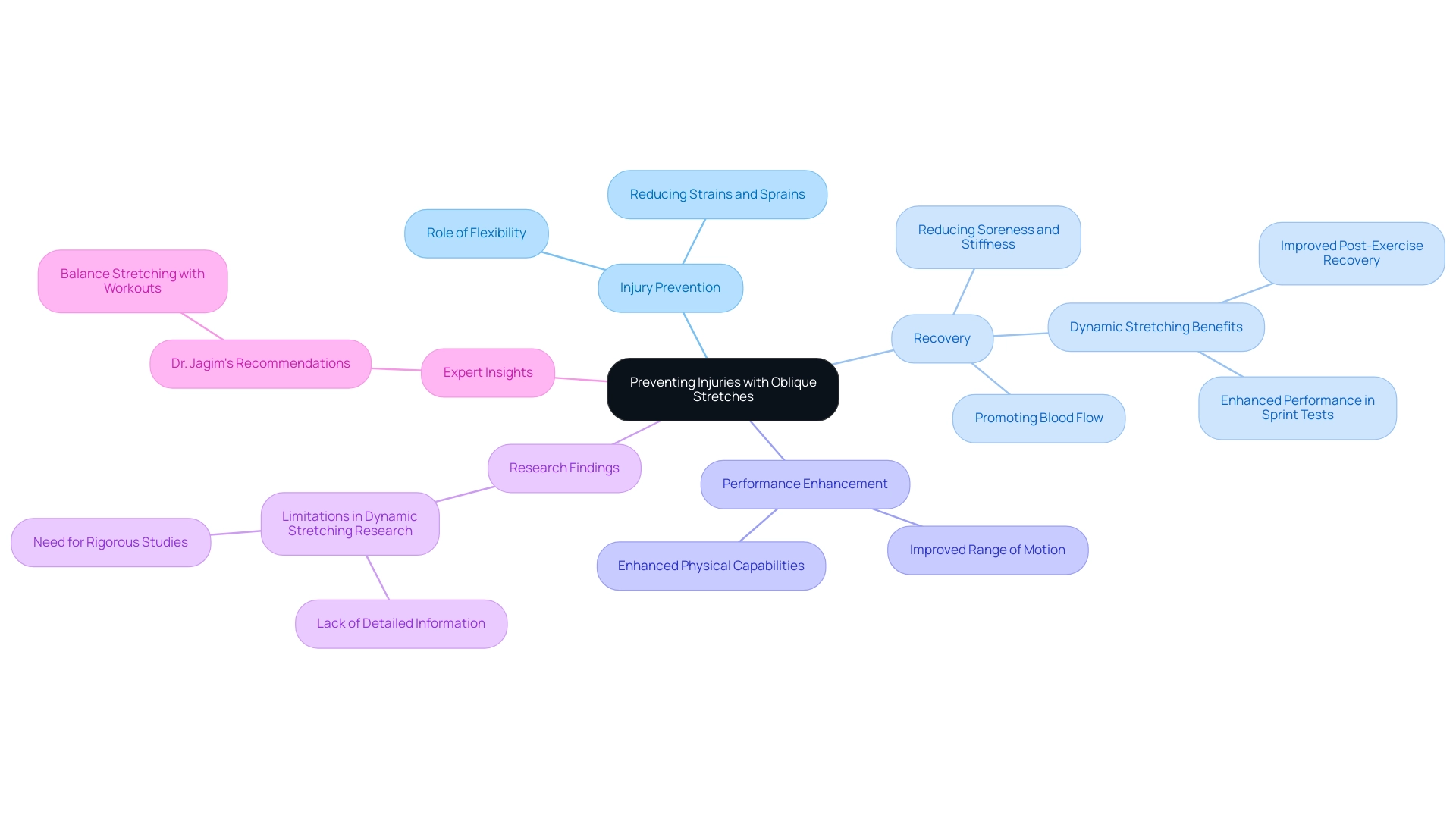
Tips for Effective and Safe Oblique Stretching Practices
To ensure effective and safe oblique stretching practices, consider the following essential tips:
-
Warm Up First: Engaging in light activity for at least 5-10 minutes before flexibility exercises is crucial. This increases blood flow to the muscles, enhancing flexibility and reducing the risk of injury. Research indicates that a proper warm-up can improve performance and prepare the body for more intense physical activity.
-
Breathe Deeply: Concentrate on your breathing throughout the stretching process. Inhale deeply to prepare your body, and as you exhale, gently enhance the extension. This not only aids in relaxation but also improves the effectiveness of the exercise.
-
Avoid Bouncing: Perform exercises in a slow and controlled manner. Bouncing can lead to muscle strains and injuries, undermining the advantages of flexibility exercises. Instead, hold each stretch for 15-30 seconds to allow the muscles to relax and elongate. Notably, 95.3% of flexibility sessions were supervised by coaches, highlighting the importance of professional guidance in ensuring safe practices.
-
Listen to Your Body: It’s vital to pay attention to your body’s signals during stretching. If you feel pain or discomfort, ease off the extension. Stretching should feel good and should not cause pain; this awareness can prevent injuries and promote a more effective routine.
-
Stay Consistent: Incorporate oblique stretches into your regular fitness routine to achieve the best results. Consistency is key to improving flexibility and overall muscle health. Consistent flexibility exercises have been shown to enhance performance and reduce fatigue, contributing to a more productive work environment. As Luís Felipe Câmara-Gomes noted, there is a theoretical basis in the literature to support the performance of flexibility exercises as a non-pharmacological strategy for the treatment of chronic low back pain, further emphasizing the benefits of flexibility in the workplace context.
By following these guidelines, individuals can safely enhance their flexibility and overall well-being, which is essential for maintaining a high-performing lifestyle in the workplace. Furthermore, referring to the case study titled "Bias Assessment in Stretching Studies" can provide context on the quality and methodologies of these practices, reinforcing the importance of safe exercise techniques. This aligns with Foresight Health Coaching's mission of fostering a cohesive team culture and improving employee health.
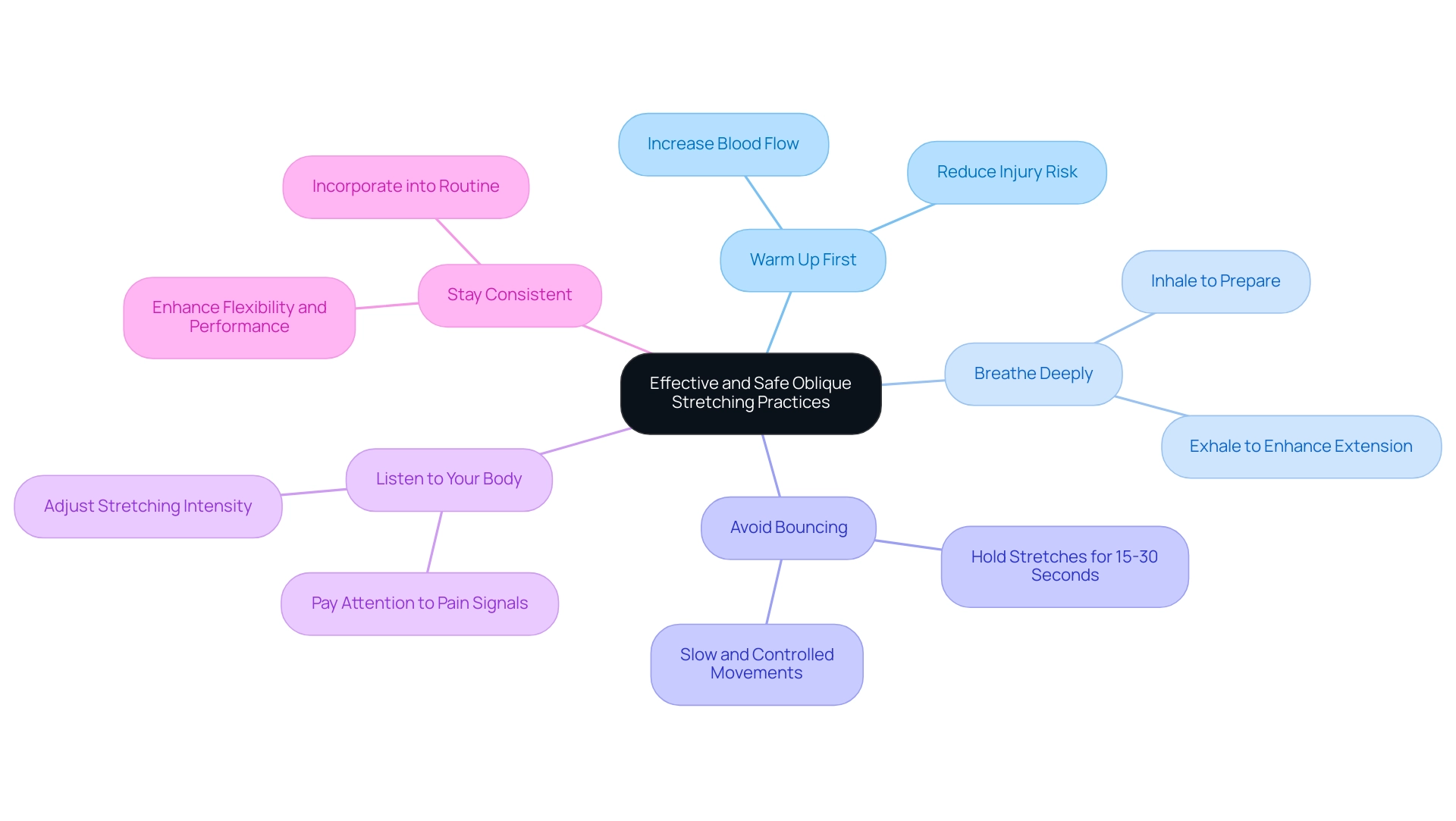
Integrating Oblique Stretches into Your Fitness Routine for Long-Term Benefits
Incorporating how to stretch your obliques into your fitness routine presents a multitude of long-term benefits that can significantly enhance overall health and performance, particularly within the framework of Foresight Health Coaching's corporate wellness programs. Regular elongation not only enhances flexibility—an essential component for mobility and physical activity—but also plays a vital role in injury prevention, recovery support, and posture improvement. Research indicates that individuals who participate in flexibility exercises regularly experience a marked reduction in injury rates, with statistics showing that consistent flexibility work can lower the likelihood of strains and sprains by up to 30%.
To effectively integrate exercises on how to stretch your obliques, it is beneficial to allocate specific time for flexibility sessions post-workout or to weave them into your warm-up routine. This practice not only fosters a culture of health but also encourages team cohesion, as employees can participate together, enhancing their collective well-being. By incorporating flexibility exercises as a regular element of your fitness regimen, you can expect to see enhancements in physical health, athletic performance, and overall workplace morale, all of which are key objectives of Foresight Health Coaching's corporate partnership.
Moreover, expert opinions emphasize the significance of maintaining a consistent flexibility routine. As noted by Howard E. LeWine, MD, "It takes weeks to months to get flexible, and you'll have to continue working on it to maintain it." This highlights the necessity of ongoing effort in developing adaptability.
Additionally, the case study titled "Comparative Effects of Passive vs. 'Active Flexibility Exercises'" implies that passive flexibility routines produce greater benefits on elasticity in contrast to active techniques, offering a detailed insight into efficient flexibility methods pertinent to workplace wellness.
Furthermore, the statistics indicating a 95% prediction interval of −0.56 to 0.67 suggest unclear effects in future studies, highlighting the need for continued research in this area. Organizations that emphasize flexibility within their wellness programs can cultivate a healthier, more resilient workforce. Real-world examples demonstrate that companies implementing structured stretching initiatives report increased employee satisfaction and reduced absenteeism, showcasing the tangible benefits of investing in team health through partnerships with Foresight Health Coaching.
In summary, incorporating how to stretch your obliques into your fitness routine not only enhances individual performance but also contributes to a thriving workplace culture, ultimately leading to a happier and more productive team. By aligning these practices with Foresight Health Coaching's corporate partnership, organizations can further their mission of fostering a healthier workplace culture. Contact us now to discover how we can partner together to nurture a stronger and more resilient team culture.
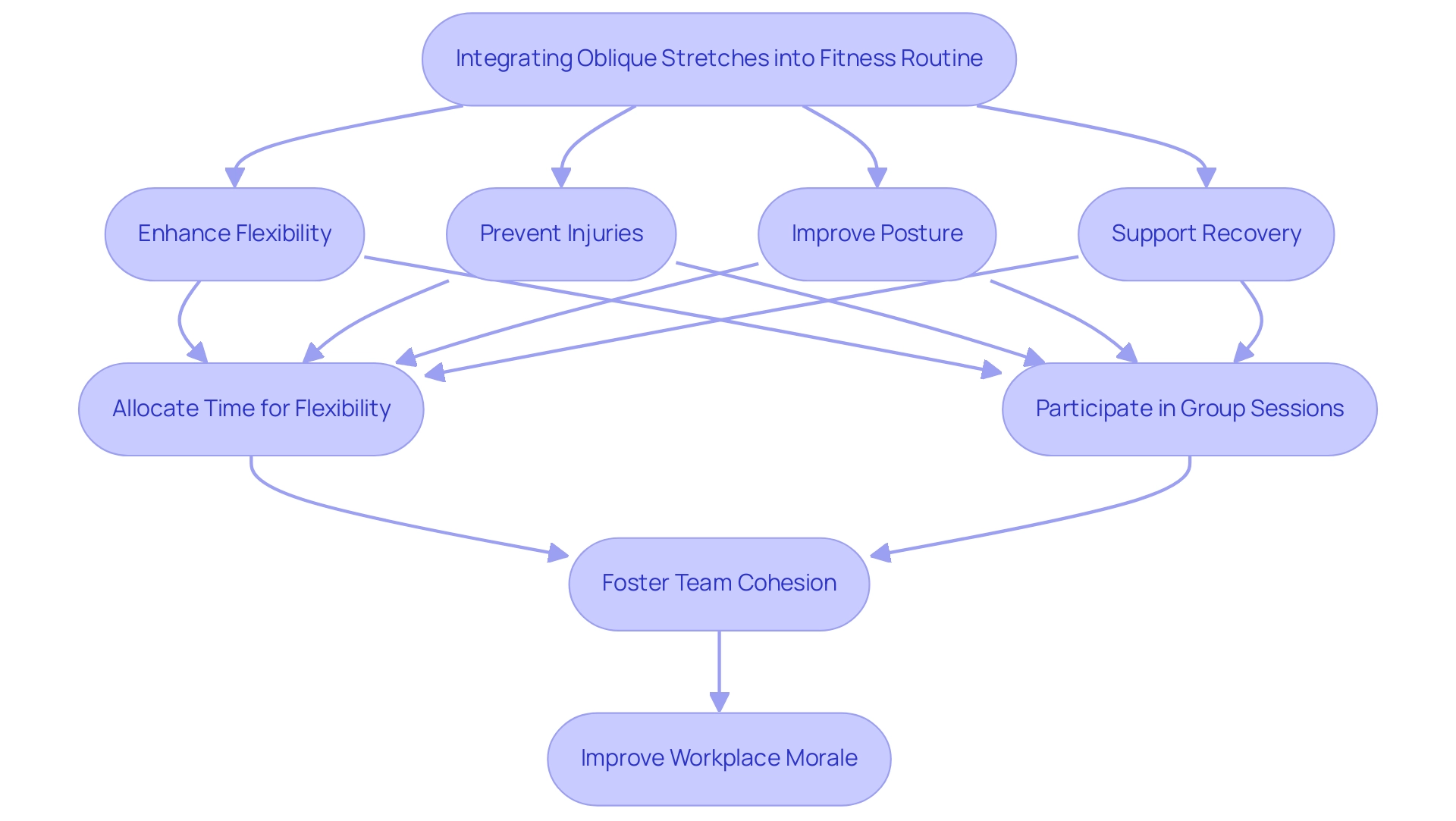
Conclusion
The significance of oblique muscles in both athletic performance and everyday movements cannot be overstated. These muscles, located on the sides of the abdomen, are integral for trunk rotation, lateral flexion, and maintaining overall core stability. Strengthening the obliques not only enhances athletic capabilities—evident in improved performance metrics among athletes—but also plays a crucial role in injury prevention. Research consistently highlights the correlation between strong obliques and better balance, agility, and rotational power, further emphasizing their importance in sports such as baseball and golf.
Furthermore, the benefits of stretching the obliques are equally vital. Enhanced flexibility contributes to better posture, reduces the risk of injuries, and alleviates discomfort, particularly in the lower back. Incorporating effective oblique stretches into daily routines promotes blood circulation and muscle recovery, which are essential for maintaining overall physical health. The integration of stretching into corporate wellness programs can lead to improved employee well-being and productivity, fostering a healthier work environment.
Ultimately, prioritizing oblique muscle training and stretching is essential for anyone looking to improve their physical capabilities and overall fitness. By recognizing the critical role these muscles play in both health and performance, individuals and organizations can cultivate a robust culture of wellness that supports long-term success. Embracing this holistic approach not only enhances personal fitness but also contributes to a more resilient and engaged team dynamic.
Frequently Asked Questions
What are the slanted muscles, and why are they important?
The slanted muscles, located on the sides of the abdomen, are essential for a variety of physical activities. They consist of external and internal muscles that facilitate trunk rotation, lateral flexion, stabilize the core, and enhance movement efficiency, which is vital for maintaining proper posture and supporting the spine.
How do the external and internal oblique muscles differ?
The external oblique muscles are the largest and most superficial, extending diagonally from the lower ribs to the pelvis, primarily aiding in trunk rotation and lateral flexion. The internal oblique muscles lie beneath them and work synergistically to stabilize the core and enhance movement efficiency.
What role do these muscles play in athletic performance?
Strong side muscles contribute to improved athletic performance by enhancing rotational power, which is crucial in sports such as baseball and golf. Athletes with well-developed side muscles are more likely to excel in rotational sports.
How does stretching the obliques affect physical performance?
Learning how to stretch the obliques through targeted exercises can significantly increase overall physical performance, including better balance and agility.
What are some real-world examples of the benefits of strong lateral muscles?
A collegiate soccer team study showed that players who focused on strengthening their side muscles improved their sprinting speed and agility. Professional athletes also incorporate targeted training to enhance their performance metrics.
What statistics highlight the importance of lateral muscles in sports?
Studies indicate that athletes with strong lateral muscles are 30% more likely to excel in rotational sports compared to those with weaker core muscles, emphasizing the need for specialized training programs.
How does flexibility relate to overall health and performance?
Enhanced flexibility contributes to better posture, reduces the risk of injuries, and correlates with a lower risk of all-cause mortality. Improved flexibility also alleviates tension in the lower back, enhancing overall physical performance.
What benefits can employees gain from participating in flexibility routines?
Employees who engage in regular flexibility routines report improved posture, reduced discomfort, and enhanced productivity, which can lead to increased motivation and engagement in the workplace.
How can organizations benefit from incorporating flexibility and mobility workshops?
Organizations that include flexibility and mobility workshops in their wellness programs can foster a healthier team culture and improve workplace performance metrics, aligning with the growing recognition of wellness initiatives.
What services does Foresight Health Coaching offer to support workplace wellness?
Foresight Health Coaching provides tailored corporate memberships that include in-person wellness talks, nutrition services, and access to a health and wellness app, designed to promote a healthy workplace environment.

